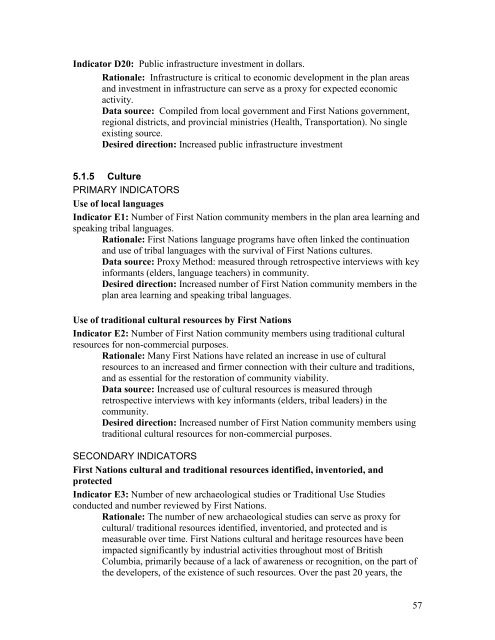Final report - Integrated Land Management Bureau
Final report - Integrated Land Management Bureau
Final report - Integrated Land Management Bureau
You also want an ePaper? Increase the reach of your titles
YUMPU automatically turns print PDFs into web optimized ePapers that Google loves.
Indicator D20: Public infrastructure investment in dollars.<br />
Rationale: Infrastructure is critical to economic development in the plan areas<br />
and investment in infrastructure can serve as a proxy for expected economic<br />
activity.<br />
Data source: Compiled from local government and First Nations government,<br />
regional districts, and provincial ministries (Health, Transportation). No single<br />
existing source.<br />
Desired direction: Increased public infrastructure investment<br />
5.1.5 Culture<br />
PRIMARY INDICATORS<br />
Use of local languages<br />
Indicator E1: Number of First Nation community members in the plan area learning and<br />
speaking tribal languages.<br />
Rationale: First Nations language programs have often linked the continuation<br />
and use of tribal languages with the survival of First Nations cultures.<br />
Data source: Proxy Method: measured through retrospective interviews with key<br />
informants (elders, language teachers) in community.<br />
Desired direction: Increased number of First Nation community members in the<br />
plan area learning and speaking tribal languages.<br />
Use of traditional cultural resources by First Nations<br />
Indicator E2: Number of First Nation community members using traditional cultural<br />
resources for non-commercial purposes.<br />
Rationale: Many First Nations have related an increase in use of cultural<br />
resources to an increased and firmer connection with their culture and traditions,<br />
and as essential for the restoration of community viability.<br />
Data source: Increased use of cultural resources is measured through<br />
retrospective interviews with key informants (elders, tribal leaders) in the<br />
community.<br />
Desired direction: Increased number of First Nation community members using<br />
traditional cultural resources for non-commercial purposes.<br />
SECONDARY INDICATORS<br />
First Nations cultural and traditional resources identified, inventoried, and<br />
protected<br />
Indicator E3: Number of new archaeological studies or Traditional Use Studies<br />
conducted and number reviewed by First Nations.<br />
Rationale: The number of new archaeological studies can serve as proxy for<br />
cultural/ traditional resources identified, inventoried, and protected and is<br />
measurable over time. First Nations cultural and heritage resources have been<br />
impacted significantly by industrial activities throughout most of British<br />
Columbia, primarily because of a lack of awareness or recognition, on the part of<br />
the developers, of the existence of such resources. Over the past 20 years, the<br />
57
















